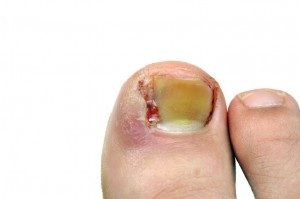What is an Ingrown Toenail?
 When a toenail is ingrown, the nail is curved downward and grows into the skin, usually at the nail borders (the sides of the nail). This “digging in” of the nail irritates the skin, often creating pain, redness, swelling, and warmth in the toe. If an ingrown nail causes a break in the skin, bacteria may enter and cause an infection in the area, which is often marked by drainage and a foul odor. However, even if your toe isn’t painful, red, swollen, or warm, a nail that curves downward into the skin can progress to an infection.
When a toenail is ingrown, the nail is curved downward and grows into the skin, usually at the nail borders (the sides of the nail). This “digging in” of the nail irritates the skin, often creating pain, redness, swelling, and warmth in the toe. If an ingrown nail causes a break in the skin, bacteria may enter and cause an infection in the area, which is often marked by drainage and a foul odor. However, even if your toe isn’t painful, red, swollen, or warm, a nail that curves downward into the skin can progress to an infection.
What Causes an Ingrown Toenail?
- Inherited
- Trauma
- Improper trimming. Cutting your nails too short encourages the skin next to the nail to fold over the nail
- Wearing shoes that are tight or short
- Toenail fungal infection
Treatment-Ingrown toenail care
If you don’t have an infection or any of the above conditions, you can soak your foot in room-temperature water (add Epsom’s salt if you wish), and gently massage the side of the nail fold to help reduce the inflammation. Avoid attempting “bathroom surgery.” Repeated cutting of the nail can cause the condition to worsen over time. If your symptoms fail to improve, it’s time to see a foot and ankle surgeon. Physician care: The foot and ankle surgeon will examine your toe and select the treatment best suited for you. See this form for print out of treatment after procedure. Treatment may include:
- Oral antibiotics. If an infection is present, an oral antibiotic may be prescribed.
- Surgery. A simple procedure, often performed in the office, is commonly needed to ease the pain and remove the offending nail. Surgery may involve numbing the toe and removing a corner of the nail, a larger portion of the nail, or the entire nail.
- Permanent removal (matrixectomy). Various techniques may be used to destroy or remove the nail root. This treatment prevents the recurrence of an ingrown toenail. Your foot and ankle surgeon will determine the most appropriate procedure for you. Following nail surgery, a light bandage will be applied. Most people experience very little pain after surgery and may resume normal activity the next day. If your foot and ankle surgeon has prescribed an oral antibiotic, be sure to take all the medication, even if your symptoms have improved. See Video below of how Dr. Dennis Timko performs a partial matrixectomy (permanent removal)
Preventing
- Trim your nails properly.
- Cut your toenails in a fairly straight line
- Don’t cut them too short. You should be able to get your fingernail under the sides and end of the nail.
- Avoid poorly-fitting shoes. Don’t wear shoes that are short or tight in the toe box. Also avoid shoes that are loose, because they too cause pressure on the toes, especially when you run or walk briskly.
Accepted Insurance Plans
Health insurance plans in Missouri that Arch City Foot & Ankle are contracted to:
- United Health Care
- Blue Cross and Blue Shield
- Anthem BCBS
- Medicare
- Medicaid
- Railroad Medicare
- Cigna
- Aetna
- GHP
- Advantra
- Mercy
- Healthlink
- Healthcare USA
Please contact the office if your insurance plan is not listed above.
